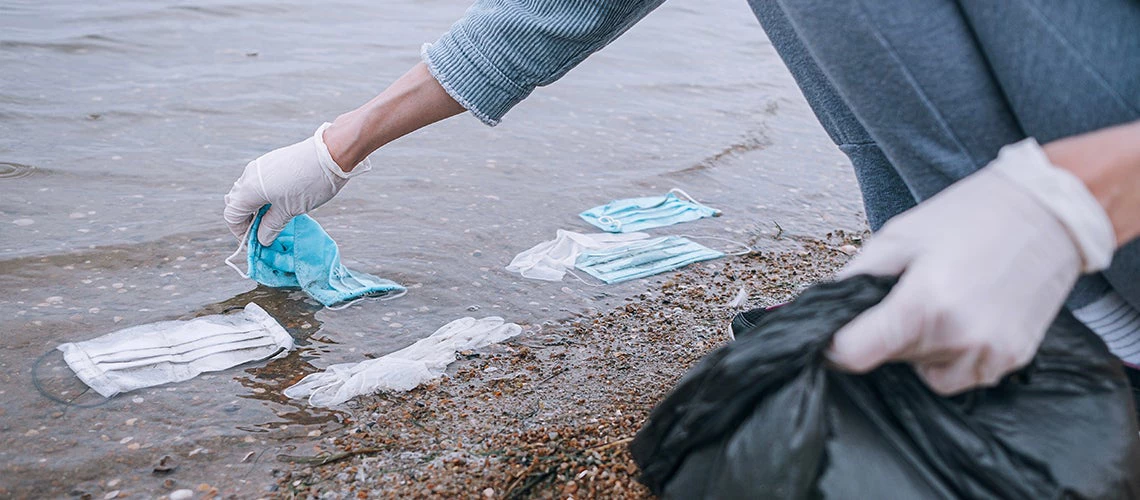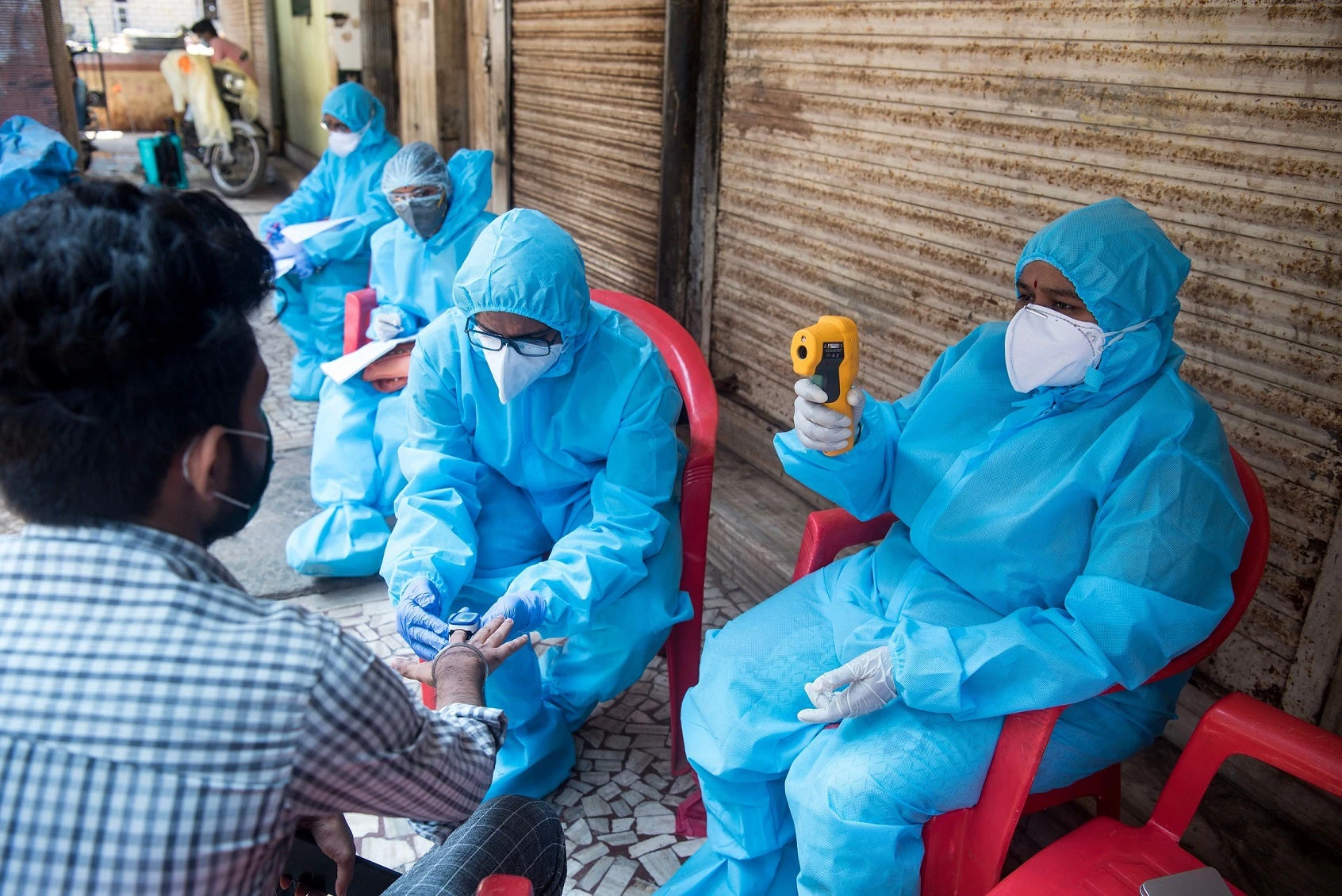 Female volunteer removes debris from used medical masks and gloves on the beach and in the water.
Female volunteer removes debris from used medical masks and gloves on the beach and in the water.
Do you have your mask?
This question has become ubiquitous in life. Undoubtedly, masks save lives. Yet, their disposal has become a common waste management problem across South Asia. Before the COVID-19 pandemic hit, South Asia was already one of the largest sources of plastics waste globally and was on the path to doubling its total waste generation by 2050. Bangladesh, India, and Pakistan ranked among the 20 countries worldwide that generated the most mismanaged plastics waste. The Indus and Ganges are among the world’s 10 most polluted river systems, receiving 90 percent of the plastics waste from the region.
The Impact of COVID-19 on Plastic Waste Management in South Asia, a research note just published by the World Bank, explores the impact of plastic use and disposal and found that pandemic-induced lifestyle changes will exacerbate the already acute plastics waste challenges in the region unless urgent action is taken.
Our Pandemic Lifestyle: A new normal
To start with, personal protective equipment or PPE became essential to minimize the spread of infections. Estimates show 87% of the excess plastic waste was from hospitals, rather than from individual use. But without fully developed solid waste management systems, South Asian countries cannot adequately manage waste from hospitals and other clinical settings.
For example, about 129 billion disposable masks are used every month worldwide. That’s about 3 million per minute and 50,000 per second! These masks made from plastic microfibers make up just a small part of tons of pandemic-associated plastic waste that is generated. Estimates indicate 1.56 billion face masks end up in the ocean over the year. This amounts to another 4,600 to 6,200 metric tons of marine plastics waste. That’s roughly equivalent to as many as 62 blue whales – the largest animal on Planet Earth, 100 ft long and weighing in at around 180,000 kgs.
The Impact of COVID-19 on Plastic Waste Management in South Asia also underlines that:
- Social distancing led to an increase in at-home deliveries: According to one estimate, the global plastic packaging market is projected to grow from about $909 billion in 2019 to more than $1 trillion by 2021.
- The recycling market is drying up: Due to countrywide lockdowns, informal waste pickers—who play a key role in solid waste management in South Asia—were either unable to supply recyclers with raw material or they couldn’t find recyclers willing to buy their materials. Informal waste collectors across India, Philippines, Vietnam, Thailand, and Indonesia collected 65 percent less plastic in volume, while recyclers perceived an average 50 percent drop in demand for their recycled plastic.
- The economics of plastics have added to the complexity: Low oil prices made it more cost-effective to produce virgin plastic, making recycling less appealing. This was compounded by the plastics industry’s advocacy of single-use plastics as the more hygienic option to combatting the COVID-19 virus, arguing that germs thrive on reusable materials that are often not washed.
Solutions?
Concerted action is needed to reduce plastic waste leakage into the environment and several solutions can be integrated into pandemic recovery plans:
- With the World Bank’s support, countries working towards a Green, Resilient, and Inclusive Recovery can incorporate business models to avoid and replace single-use plastics, such as delivery services to provide non-plastic degradable packaging.
- Proper segregation of medical and hazardous waste from municipal solid waste is another essential quick win. Guidelines for hospital and clinic staff from doctors and nurses to cleaners are available.
- By integrating informal workers and their organizations into disaster risk management plans and national COVID-19 recovery plans, governments can ensure the continuity of essential waste management services during an emergency and prevent loss of livelihoods while generating pathways towards more formal employment.
- To lessen reliance on single use plastics, governments, private sector and advocacy groups can endorse the hygienic safety of reusable dishware systems to empower consumers to make more informed choices while boosting sustainable businesses and spurring local jobs that are integral to a circular plastic economy during the COVID-19 recovery period.
There is no silver bullet to solving the problem of plastics pollution across the rivers and seas of South Asia. Interventions are needed at every stage of the plastic lifecycle: from production and stopping plastic leakage through investments in solid waste management to transitioning to a circular economy approach for plastics.
The COVID-19 pandemic has exacerbated the problem of plastics management across Asia, and the World Bank is committed to helping South Asian nations reduce plastic pollution for the billions of people whose livelihoods depend on healthy rivers and seas. Now is the time to push for new policies, investments, and innovations so that South Asian countries can build back from the pandemic greener and more resilient.
This work is part of the World Bank’s program on South Asia Marine Plastics Pollution, which aims to promote circular plastic economy solutions, advance country-level policy and investment dialogues, and raise awareness of the deleterious impacts of marine plastics pollution on people’s lives and livelihoods. It supports the Bank’s commitment to work with countries of South Asia, civil society partners and the private sector to bring innovative and sustainable solutions for plastic waste reduction and management across the region.





Join the Conversation